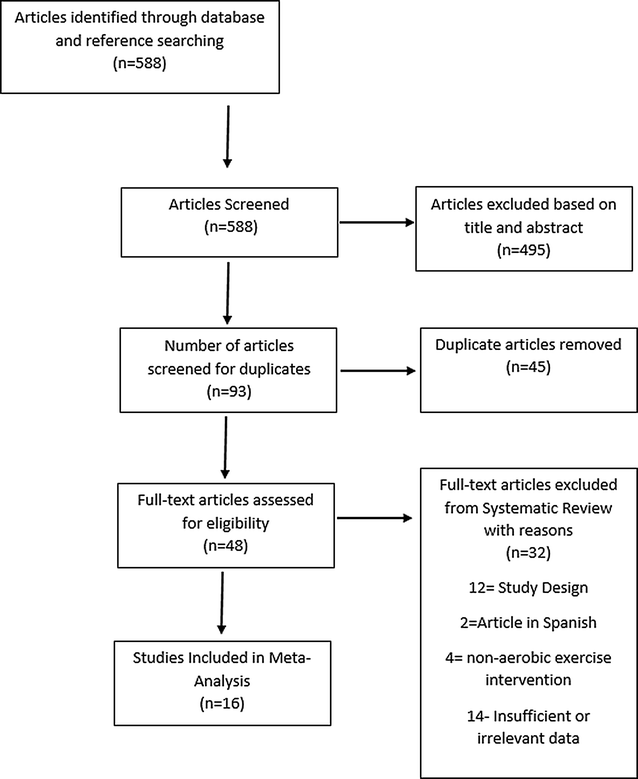The effect of exercise training on clinical outcomes in patients with the metabolic syndrome: a systematic review and meta-analysis
- PMID: 28854979
- PMCID: PMC5577843
- DOI: 10.1186/s12933-017-0590-y
The effect of exercise training on clinical outcomes in patients with the metabolic syndrome: a systematic review and meta-analysis
Abstract
Background: Purpose: to establish if exercise training improves clinical outcomes in people with metabolic syndrome (MetS). Registered with PROSPERO international prospective register of systematic reviews ( https://www.crd.york.ac.uk/PROSPERO/Identifier:CRD42017055491 ).
Data sources: studies were identified through a MEDLINE search strategy (1985 to Jan 12, 2017), Cochrane controlled trials registry, CINAHL and SPORTDiscus.
Study selection: prospective randomized or controlled trials of exercise training in humans with metabolic syndrome, lasting 12 weeks or more.
Results: We included 16 studies with 23 intervention groups; 77,000 patient-hours of exercise training. In analyses of aerobic exercise studies versus control: body mass index was significantly reduced, mean difference (MD) -0.29 (kg m-2) (95% CI -0.44, -0.15, p < 0.0001); body mass was significantly reduced, MD -1.16 kg (95% CI -1.83, -0.48, p = 0.0008); waist circumference was significantly reduced MD -1.37 cm (95% CI -2.02, -0.71, p < 0.0001), peak VO2 was significantly improved MD 3.00 mL kg-1 min-1 (95% CI 1.92, 4.08, p < 0.000001); systolic blood pressure and diastolic blood pressure were significantly reduced, MD -2.54 mmHg (95% CI -4.34, -0.75, p = 0.006), and, MD -2.27 mmHg (95% CI -3.47, -1.06, p = 0.0002) respectively; fasting blood glucose was significantly reduced MD -0.16 mmol L-1 (95% CI -0.32, -0.01, p = 0.04); triglycerides were significantly reduced MD -0.21 mmol L-1 (95% CI -0.29, -0.13, p < 0.00001); and low density lipoprotein was significantly reduced MD -0.03 mmol L-1 (95% CI -0.05, -0.00, p = 0.02). In analyses of combined exercise versus control: waist circumference, MD -3.80 cm (95% CI -5.65, -1.95, p < 0.0001); peak VO2 MD 4.64 mL kg-1 min-1 (95% CI 2.42, 6.87, p < 0.0001); systolic blood pressure MD -3.79 mmHg (95% CI -6.18, -1.40, p = 0.002); and high density lipoprotein (HDL) MD 0.14 (95% CI 0.04, 0.25, p = 0.009) were all significantly improved. We found no significant differences between outcome measures between the two exercise interventions.
Conclusions: Exercise training improves body composition, cardiovascular, and, metabolic outcomes in people with metabolic syndrome. For some outcome measures, isolated aerobic exercise appears optimal.
Keywords: Exercise training; Meta-analysis; Metabolic syndrome.
Similar articles
-
Effects of total fat intake on bodyweight in children.Cochrane Database Syst Rev. 2018 Jul 5;7(7):CD012960. doi: 10.1002/14651858.CD012960.pub2. Cochrane Database Syst Rev. 2018. PMID: 29974953 Free PMC article.
-
Effects of total fat intake on bodyweight in children.Cochrane Database Syst Rev. 2018 Feb 15;2(2):CD012960. doi: 10.1002/14651858.CD012960. Cochrane Database Syst Rev. 2018. Update in: Cochrane Database Syst Rev. 2018 Jul 05;7:CD012960. doi: 10.1002/14651858.CD012960.pub2. PMID: 29446437 Free PMC article. Updated.
-
The effect of exercise on the cardiovascular risk factors constituting the metabolic syndrome: a meta-analysis of controlled trials.Sports Med. 2013 Feb;43(2):121-33. doi: 10.1007/s40279-012-0003-z. Sports Med. 2013. PMID: 23329606 Free PMC article.
-
Pulmonary rehabilitation versus usual care for adults with asthma.Cochrane Database Syst Rev. 2022 Aug 22;8(8):CD013485. doi: 10.1002/14651858.CD013485.pub2. Cochrane Database Syst Rev. 2022. PMID: 35993916 Free PMC article.
-
Aerobic exercise training for adults with fibromyalgia.Cochrane Database Syst Rev. 2017 Jun 21;6(6):CD012700. doi: 10.1002/14651858.CD012700. Cochrane Database Syst Rev. 2017. PMID: 28636204 Free PMC article.
Cited by
-
Effectiveness of Mobile Health Interventions Promoting Physical Activity and Lifestyle Interventions to Reduce Cardiovascular Risk Among Individuals With Metabolic Syndrome: Systematic Review and Meta-Analysis.J Med Internet Res. 2020 Aug 31;22(8):e17790. doi: 10.2196/17790. J Med Internet Res. 2020. PMID: 32865503 Free PMC article.
-
Exercise and the Heart: Benefits, Risks and Adverse Effects of Exercise Training.Rev Cardiovasc Med. 2023 Mar 23;24(3):94. doi: 10.31083/j.rcm2403094. eCollection 2023 Mar. Rev Cardiovasc Med. 2023. PMID: 39077491 Free PMC article. Review.
-
The Effects of Concurrent Training Combining Both Resistance Exercise and High-Intensity Interval Training or Moderate-Intensity Continuous Training on Metabolic Syndrome.Front Physiol. 2020 Jun 11;11:572. doi: 10.3389/fphys.2020.00572. eCollection 2020. Front Physiol. 2020. PMID: 32595518 Free PMC article.
-
How Does Obesity and Physical Activity Affect Aging?: Focused on Telomere as a Biomarker of Aging.J Obes Metab Syndr. 2019 Jun;28(2):92-104. doi: 10.7570/jomes.2019.28.2.92. Epub 2019 Jun 30. J Obes Metab Syndr. 2019. PMID: 31294341 Free PMC article. Review.
-
Heart failure in patients with metabolic syndrome X.Discoveries (Craiova). 2023 Mar 3;11(1):e162. doi: 10.15190/d.2023.1. eCollection 2023 Jan-Mar. Discoveries (Craiova). 2023. PMID: 37496710 Free PMC article. Review.
References
-
- Alberti KG, Eckel RH, Grundy SM, Zimmet PZ, Cleeman JI, Donato KA, Fruchart JC, James WP, Loria CM, Smith SC, Jr, et al. Harmonizing the metabolic syndrome: a joint interim statement of the international diabetes federation task force on epidemiology and prevention; national heart, lung, and blood institute; American heart association; world heart federation; international atherosclerosis society; and international association for the study of obesity. Circulation. 2009;120(16):1640–1645. doi: 10.1161/CIRCULATIONAHA.109.192644. - DOI - PubMed
-
- Haqq L, McFarlane J, Dieberg G, Smart N. The effect of lifestyle intervention on body composition, glycemic control, and cardiorespiratory fitness in polycystic ovarian syndrome: a systematic review and meta-analysis. Int J Sport Nutr Exerc Metab. 2015;25(6):533–540. doi: 10.1123/ijsnem.2013-0232. - DOI - PubMed
Publication types
MeSH terms
LinkOut - more resources
Full Text Sources
Other Literature Sources
Medical
Miscellaneous


